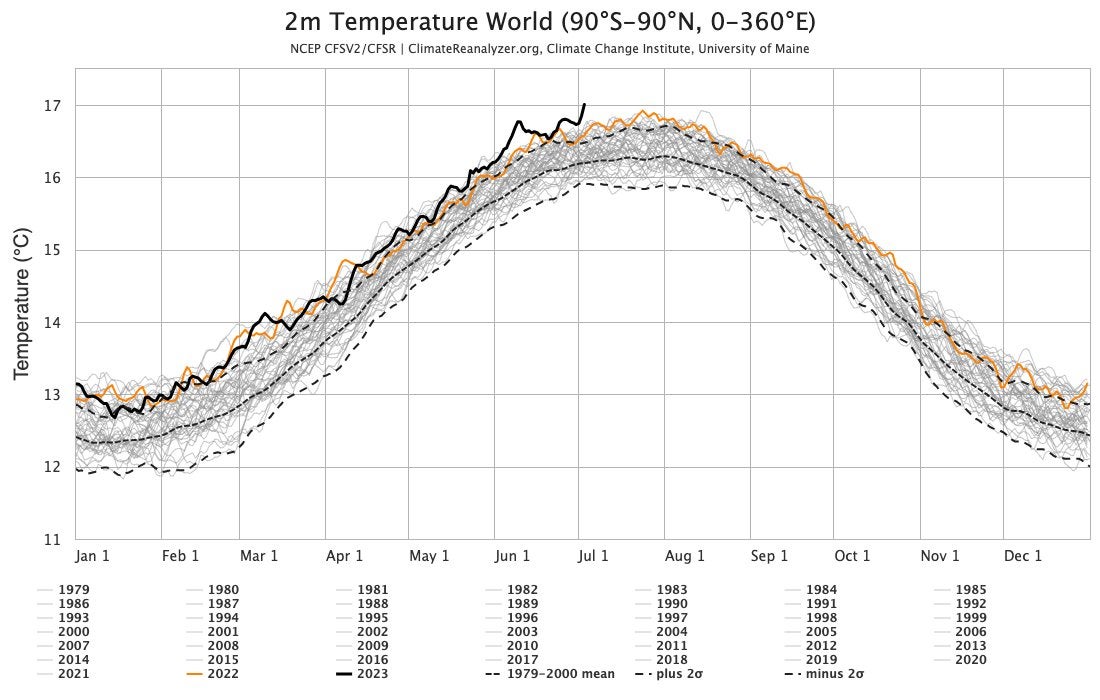Earth’s record high temperature maintained for second day
‘With El Niño developing, the world will likely break this record again in the coming months. We absolutely need to stop burning fossil fuels’
The planet’s average temperature was stuck at a record high on Wednesday, the latest in a wave of dangerous extremes caused by the climate crisis.
On 5 July, the average temperature of Earth was 17.18 degrees Celsius (62.9 degrees Fahrenheit), according to an unofficial record by Climate Reanalyzer, a platform which uses climate and weather forecast models.
It maintained the temperature record set on Tuesday, 4 July - which in itself topped Monday, 3rd July’s record-breaking average of 17.01C (62.6F).
The figures still must be confirmed by official international and national government bodies but nevertheless have set off alarm bells in the scientific community.
Dr Friederike Otto, climate science lecturer at the Grantham Institute for Climate Change and founder of World Weather Attribution (WWA) which assesses the role of global heating in extreme weather, called it “a death sentence for people and ecosystems”.
“This is not a milestone we should be celebrating, it’s a death sentence for people and ecosystems,” she said. “And worryingly, it won’t be the hottest day for a long time.
“With El Niño developing, the world will likely break this record again in the coming months. We absolutely need to stop burning fossil fuels.”
The new average record temperature is approximately 0.9C higher than the same day 30 years ago, when global temperatures had already been influenced by the human-caused climate crisis.
This year has already seen a series of extremes including “unheard of” marine heatwaves in UK waters, record low levels of Arctic ice and unusually early heat in Asia that affected one-third of the world’s population.
It also comes after the UK Met Office said that the country experienced its hottest June on record while the southern United States and Mexico were reeling from an intense, prolonged heatwave which killed over a hundred people.
Canada is battling hundreds of wildfires, the worst in its history, with smoke pouring over the US and even reaching some parts of Europe.
China is in the midst of an extreme heatwave with temperatures surpassing 35C, and severe flooding in parts of the country.

Meanwhile, heatwaves combined with high humidity have gripped eastern India for the second time this year after the region hit 45C in April. The usually early spring heatwave shattered tempearture records in 12 countries across Asia, and was made 30 times more likely due to climate crisis, according to scientists.
North Africa is enduring extreme temperatures with readings approaching 50C. The climate crisis has also played a substantial role in intensifying the heatwave in this region.
In the Antarctic, temperatures soared to unprecedented levels during its winter season, breaking the July record by reaching 8.7C.
The scorching heat is being driven by trapped emissions, largely caused by burning fossil fuels, as well as the new El Nino - a cyclic climate pattern which means severe temperatures in many places.

Along with intense and earlier heatwaves, the high temperatures are contributing to larger wildfires, erratic rainfall and stronger cyclones.
Since humans began burning large amounts of oil, gas and coal, around 200 years ago, the global average temperature has risen to 1.2C. Under the 2015 Paris Agreement, all countries agreed to limit temperature rise to 1.5C this century - a benchmark that has already been temporarily breached.
Extreme weather is hitting the world’s poorest communities the hardest - despite their negligible contributions to global greenhouse gas emissions.
Join our commenting forum
Join thought-provoking conversations, follow other Independent readers and see their replies
Comments


Bookmark popover
Removed from bookmarks